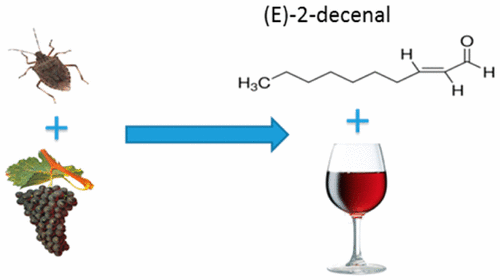Corralling stink bugs could lead to better wine

To wine makers, stink bugs are more than a nuisance. These tiny pests can hitch rides on grapes going through the wine making process, releasing stress compounds that can foul the smell and taste of the finished product. Now, in a study published in the Journal of Agricultural and Food Chemistry, scientists report the threshold of stink bugs per grape cluster that will impact the integrity of the wine.
In vineyards, brown marmorated stink bugs feed on grapes, reducing their yield and quality. And because they are small and blend in, the insects hitchhike on the grapes and wind up in the winery, giving off stress compounds that sometimes affecting the quality of the wine and juice. Pesticides used in the vineyard are not completely effective, so attention is being focused on ways to reduce the presence of the insects in wineries post-harvest. To find out exactly how grape processing impacts the release of stink bug stress compounds and how this affects wine, Elizabeth Tomasino and colleagues took a closer look.
The researchers placed varying numbers of live or dead stink bugs on grapes and measured the release of insect stress compounds as wine was produced from the fruits. They found that pressing was a key step in the release of two of the most common stress compounds—tridecane, which is odorless, and (E)-2-decenal, which produces an undesirable musty-like, coriander or cilantro aroma. Interestingly, white wine was contaminated less often than red. The researchers suggest that this is because these two wines are pressed at different points in the winemaking process. The team concludes that if winemakers could limit stink bugs to no more than three per grape cluster, the levels of tridecane and (E)-2-decenal in wine would be below the consumer rejection threshold.
More information: Pallavi Mohekar et al. Influence of Winemaking Processing Steps on the Amounts of ()-2-Decenal and Tridecane as Off-Odorants Caused by Brown Marmorated Stink Bug (), Journal of Agricultural and Food Chemistry (2017). DOI: 10.1021/acs.jafc.6b04268
Abstract
Brown marmorated stink bugs (BMSB) release stress compounds, tridecane and (E)-2-decenal, that affect final wine quality. This study focuses on determining the effect of wine processing on (E)-2-decenal and tridecane release in both red and white wines. Wines were produced by adding live BMSB to grape clusters at densities of 0, 0.3, 1, and 3 bugs/cluster. Compound concentrations were measured using headspace solid phase microextraction with multidimensional gas chromatography and mass spectrometry. For red wines, the highest levels of stress compounds were found using 3 BMSB/cluster [tridecane, 614 μg/L; (E)-2-decenal, 2.0 μg/L]. Pressing was found to be the critical process point for stress compound release, and additional pressing processes, press types, and press fractions were investigated. BMSB taint for white wines was not found to be problematic with respect to wine quality. An action control of 3 BMSB/cluster is recommended as this was related to the known consumption rejection threshold for (E)-2-decenal.
Journal information: Journal of Agricultural and Food Chemistry
Provided by American Chemical Society



















